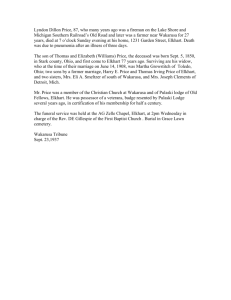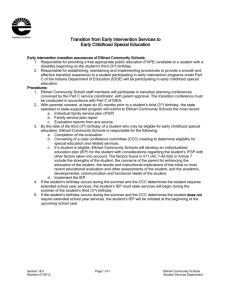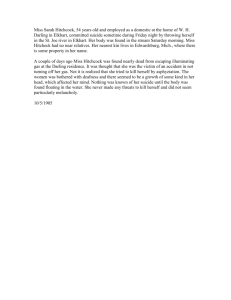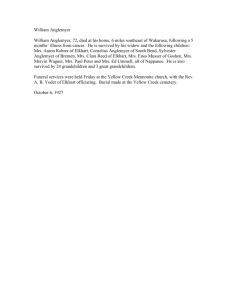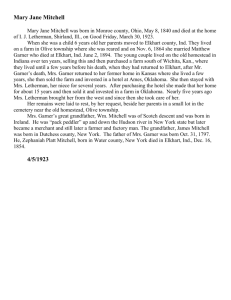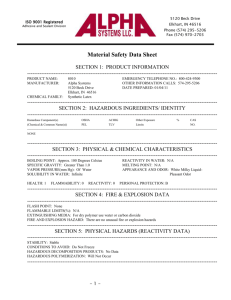Ask Questions
advertisement
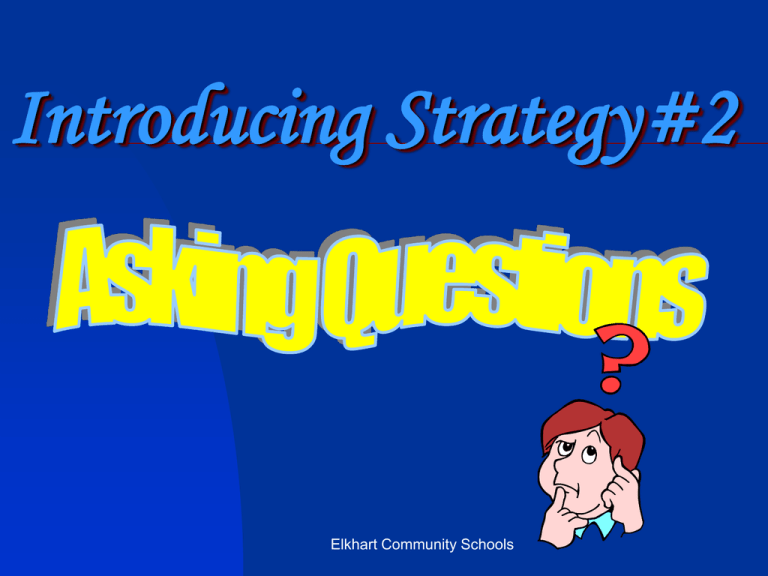
Introducing Strategy#2 Elkhart Community Schools When kids are little…. They can’t stop asking questions. They drive their family crazy with, “Why does the kitty land on its feet when you throw it in the air? Why do I have two eyes? Why do I have to go to bed?” Relentlessly, they examine their environment, trying to make sense of it. Elkhart Community Schools However…. …many kids don’t come to school with language skills sophisticated enough to allow them to formulate formal questions. Elkhart Community Schools Why is this a problem? Elkhart Community Schools The Importance of Building “Schema” Building conceptual frameworks or schema is the way in which the mind stores and retrieves data. Abstract words are important in building schema because they allow the mind to group data. Elkhart Community Schools How Questioning Skills Help With Learning “Absolutely crucial to building conceptual frameworks or schema is the ability to ask a question syntactically.” “When an individual cannot ask questions, he/she is like a computer without a keyboard. It is very difficult to access data.” Ruby Payne Elkhart Community Schools Put in a simpler way… “Without questioning skills, you’re just a passenger on someone else’s tour bus. You may be on the highway but someone else is doing the driving.” Jamie McKenzie Elkhart Community Schools Good questioning skills require… Formal Language Structures Elkhart Community Schools With formal language: Sentences follow standard syntax Questions are posed in syntactically correct form Word choices are “specific”. Elkhart Community Schools Why is this important? Many children come to school able to only use casual language or heritage Language. When casual or heritage language is used, only about 400-500 vocabulary words are employed. The words used are general and not specific. Dependent upon nonverbal cues. Ruby Elkhart Community Schools Payne (adapted) Students might pose a question as a statement with inflection and nonverbal cues such as…. “Your sister married?” In “formal language,” the verb may go first followed by the subject. “Is your sister married?” Elkhart Community Schools Unable to use the kind of language school requires… … many kids tend to sit back and let the teacher ask the questions. They fail to get engaged in the process of trying to understand their school world. Elkhart Community Schools Being able to ask questions… helps students establish a purpose for reading and be more focused. encourages students’ curiosity enough to stay with the material until they understand. Elkhart Community Schools Being able to ask questions… helps to make the text clearer. takes students to deeper meaning to help them understand text Cris Tovani (adapted) Elkhart Community Schools Teaching Questioning Strategies Elkhart Community Schools The Gradual Release of Responsibility Independent Application Independent Practice Guided Practice Teacher Modeling Elkhart Community Schools Step 1 – Teacher Modeling When we show kids how we reap big rewards. Elkhart Community Schools “Thinking Aloud”: “The think aloud give the students the opportunity to see our thinking when we read, the connections, we make, the questions we ask, our inferences and our predictions.” “It is through the read aloud that teachers show students their thinking process when reading.” from Strategies That Work Guided Reading Elkhart Community Schools Modeling a “Think Aloud” • photos / illustrations • picture books • personal reading material • classroom materials • short text / lifted text • poetry / musical lyrics Elkhart Community Schools Teacher to Students… “Last night I was reading this book and while I was reading, I found myself asking several questions about the text.” Let me read this passage to you ….. Elkhart Community Schools Model to students that questions can come…. Before Reading During Reading After Reading Elkhart Community Schools Using a photo or picture to teach questioning: I wonder where the truck is going. I wonder what the truck is carrying. I wonder if the economy will allow truckers to keep their jobs. Tell a partner.. “I wonder…” Elkhart Community Schools Step 2 – Guided Practice Guided Practice provides kids with a scaffold to help them grow towards independence. Elkhart Community Schools Guided Practice Charts: * Two or Three Column charts * KWL Charts * Anchor Charts Elkhart Community Schools Guided Practice Types of Questions for Anchor Chart: • Questions which require only a brief answer or a yes/no answer. • Questions where there is only one correct answer. • Questions where the answer is open-ended. • Questions which require a detailed, complex answer • Questions which do not require any definite answer and are more interpretive or inferential. Elkhart Community Schools THICK QUESTIONS THICK questions address large, universal concepts… For instance, “What is photosynthesis?” You could not answer that question with one word. The answers are long and involved and need to be researched. Elkhart Community Schools THIN QUESTIONS Questions that can be answered with a number or a simple “yes, or No” fall in this category. For instance,“How many planets are there?” You use thin questions to understand specific details. Elkhart Community Schools Structure of Questions Most of us think of these words when we think of questions: Who? What? When? Where? How? Why? Elkhart Community Schools But questions can also look like this… Which of the following statements fits with . . .? Can you think of an example. . .? Could, should, would. . .? If this story happened ….? Does she/he mean that. . .? In what ways. . . ? Elkhart Community Schools Guided Practice Reciprocal Teaching: Facilitates a group effort between teacher and students as well as among students in the task of bringing meaning to text. Students and teacher take turns in leading a dialogue about text. Four activities are incorporated into the technique: prediction, questioning, summarizing and clarifying. Elkhart Community Schools Guided Practice Teaching “I wonder…” statements: Sometimes students find it easier to pose questions in the form of “I wonder…” statements. After generating the I wonder statements, teachers can demonstrate how the statement can be changed to a question with the question word coming first. Elkhart Community Schools Guided Practice Teaching coding for questioning Are questions: Answered directly in your text - A Answered from someone’s background knowledge- BK Inferred (figured out) from text- I Answered by further discussion-D Requiring further research- RS Signaling confusion- Huh? Harvey and Goudvis Elkhart Community Schools Other ideas for questioning Teacher reads a passage. Student asks a question to answer. Take turns reading and asking questions. Reread a story at least three times. Keep a list of questions and see how they change. Elkhart Community Schools Look at the front cover of a book. In two minutes, see how many questions you can create about it. Step 3: Independent Practice Students need to be able to use questioning strategies “on their own” (OTO) to become metacognitive, strategic readers. They need to learn to use the tools available to them that lead them to independent application. Elkhart Community Schools Independent Practice • Display anchor charts and previously worked on charts on display in the room. • Provide tools such as Question Matrix, Bloom’s Taxonomy, and Six Thinking Hats • Two Column Note worksheets /Graphic Organizers and Webs • Small group and / or work in pairs • Play Jeopardy or other games • Provide sticky notes for coding text Elkhart Community Schools Tools for Independent Practice Elkhart Community Schools The Question Matrix EVENT SITUATION CHOICE PERSON RESAON MEANS PRESENT What Is? Where/W hen is? Which did? Who is? Why is? How is? PAST What did? Where/ When did? Which did? Who did? Why did? How did? POSSIBILITY What can? Where/ When can? Which can? Who can? Why can? How can? PROBABILITY What would? Where/ When would? Which would? Who would? Why would? How would? PREDICTION What will? Where/ When will? Which will? Who will? Why will? How will? IMAGINATION What might? Where/ When might? Which might? Who might? Why might? How might? (C. Weiderhold ‘Co-operative Learning and Critical Thinking’ in Langrehr, Better Questions, better Thinking Book 2, Longman Cheshire, Melbourne, 1993) Elkhart Community Schools 37 Six Thinking Hats (de Bono) •White Hat Thinking: facts, figures, information needs and gaps. •Red Hat Thinking: intuition, feelings, emotions •Black Hat Thinking: judgment, caution •Yellow Hat Thinking: logical positive, why something will work, its benefits, value •Green Hat Thinking: creativity, alternatives, proposals, changes •Blue Hat Thinking: overview or process, metacognition Elkhart Community Schools Bloom’s Taxonomy Evaluation Synthesis Analysis Comprehension Application Knowledge Elkhart Community Schools Practicing Questioning in a Group Find a small group of brilliant learners. 1 Ask your questions first. Call on a volunteer to answer. 4 Decide how to read your text—aloud or silently. 2 Everyone writes 1-2 questions that could be answered. 3 Don’t allow YES/NO questions. Ask “Why do you think this?” 6 Elkhart Community Schools Ask for other volunteers to ask their questions. 5 Step 4: Independent Application The goal of comprehension instruction is to help all students take responsibility for their own learning and be self-directed rather than teacher directed. Elkhart Community Schools Making Connections Asking Questions Expanding Vocabulary Predicting Using Your Senses Deciding Importance Making Inferences Summarizing and Synthesizing Building Fluency Repairing Comprehension Elkhart Community Schools The Payoff You understand that hearing others’ questions inspires new ones of your own; likewise, listening to others’ answers can also inspire new thinking.” Debbie Miller Elkhart Community Schools
